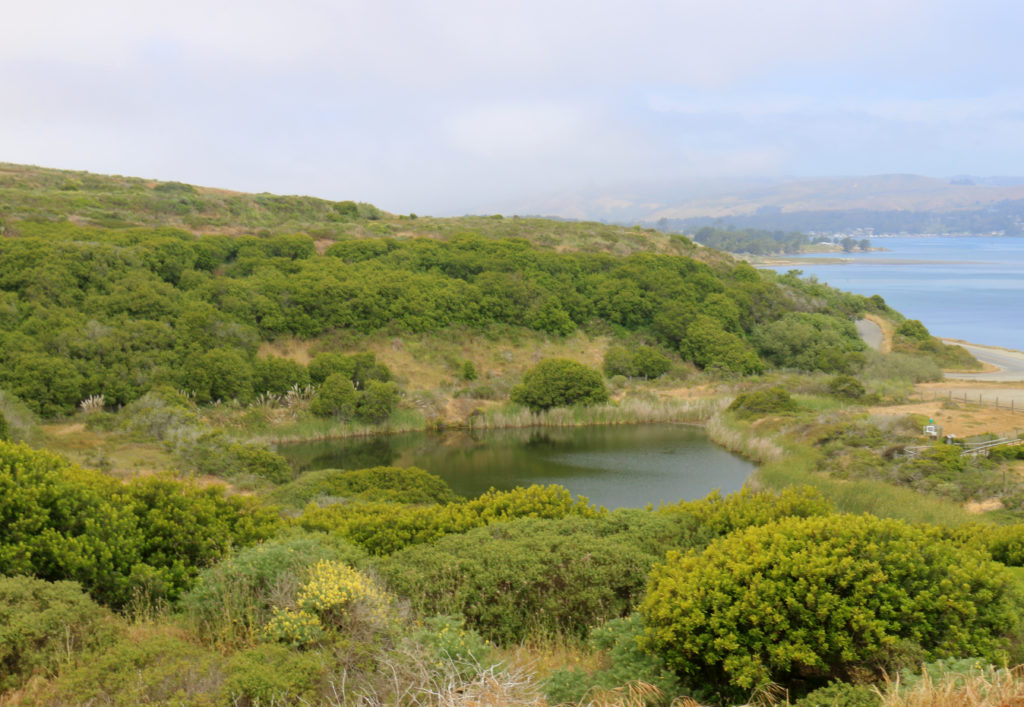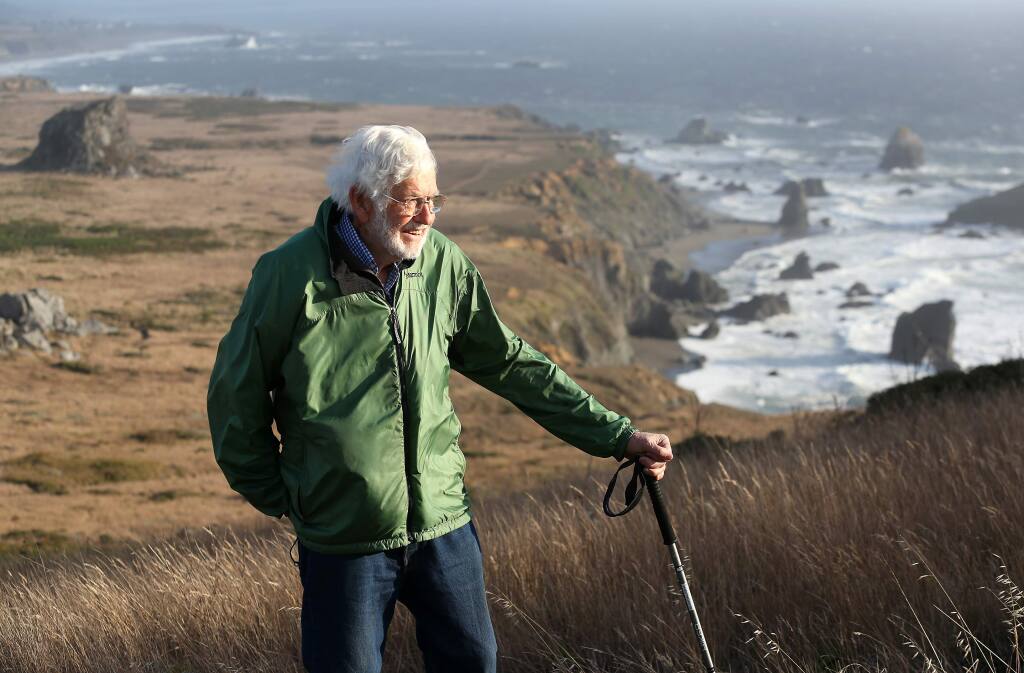Bill Kortum
The 1972 Coastal Initiative, passed by 55% of the voters, was a landmark in coastal protection for California and even the nation, and again was an expression by the public of their devotion to this magnificent coastline, the commons for all of California.
In Northern California, coastal awareness and activism started with PG&E’s 1962 attempt to build a nuclear power plant on Bodega Head. Defeated by a lively innovative group, helped by the presence of the San Andreas Fault, PG&E abandoned the site and left the excavation for the reactor as a water-filled “Hole in the Head,” monument to the battle.

From 1964 on, the numbers of projects and insults to the coastline started to multiply. Five more power plant sitings were proposed; the Santa Barbara oil spill from offshore drilling occurred; the mouth of the Russian River was to be dredged for gravel to bed the Bart tubes. These were just warnings of what was to come . Added to the industrial exploitation were land use threats of numerous housing developments clinging to the coastline from Del Norte to San Diego.
The classic example in Sonoma County was Sea Ranch. A sheep ranch with ten miles of coastal frontage to be converted to a second home development without County Supervisors insisting on public access to beaches. This in spite of State Constitution language describing public ownership to the mean high tide.
In 1968 activists in Sonoma County, challenged by the Sea Ranch precedent of privatization of the coast, formed Californians Organized to Acquire Access to State Tidelands (COAAST) and proceeded to mount an initiative that would require public access whenever coastal property was developed. The initiative lost to a massive campaign investment by the Sea Ranch developers, Castle and Cook. Two years later Assemblyman John Dunlap was successful in passing a bill that carried out the initiative language for the whole state and that still supercedes the Coastal Act.
The local Coastal Access Initiative at the time caught the attention of both Assemblymen Alan Sieroty and John Dunlap who came to Sonoma County to hold Assembly hearings on Sea Ranch and to ask COAAST to organize statewide all the groups involved with coastal protection. Their idea was to introduce legislation to create a Coastal Commission. In 1969 thirteen counties and 26 cities had traditionally been making land use decisions along the coast with no regard for the statewide consequences. None of the jurisdictions had any guidance or set of goals that would take into consideration the state’s interest in protecting its coast. Public access, visual amenities, recreation, habitat protection, water pollution, forestry, road building, industrialization, loss of agriculture, were all of statewide concern.
Sieroty and Dunlap advocated the equivalent of a planning commission with police power of zoning for the coast to suppplant local jurisdictions. Competing bills emphasized local control. But after three years of effort the Legislature failed to pass a coastal protection bill. The heavy lobbying from the energy sector, the California Real Estate Association, County Supervisors’ Association, League of California Cities, and many others, were effective in defeating the Coastal Commission legislation.
Meanwhile the 1969 statewide Coastal Coalition of twelve environmental groups urged by Sieroty and Dunlap grew into the California Coastal Alliance of 110 groups interested in saving the coast. In 1972 the Alliance, with executive director Janet Adams, launched the initiative Proposition 20, in the main adopting the language of Sieroty and Dunlap’s AB 1471. Thanks to the three years of legislative hearings and the statewide publicity describing the proposed legislation, the public had been made aware and volunteers had little trouble in gathering the signatures for the initiative. The campaign was highlighted by then Secretary of State Jerry Brown providing constant exposure of the special interest donations to defeat the measure. The measure passed comfortably.
The State Commission established by the initiative had twelve members appointed equally by the Governor, the Senate, and the Assembly. Also, five coastal regional commissions were established, using the same appointment procedure, to hold hearings and issue local permits . The State Commission, with input from the regional commissions, was to develop a California Coastal Plan to be adopted by the Legislature in 1976 at which time the Commission was to be made a permanent institution. The Commission also served as an appeals body for regional commission decisions.
The Legislature narrowly voted to carry out the mandate of Proposition 20 and they added two significant and necessary additions. To satisfy local government, the Legislature mandated that coastal counties and cities develop a local coastal plan that met the criteria of the California Coastal Plan developed by the original commission. In addition, the Legislature created the California Coastal Conservancy and appropriated money to buy coastal land and help develop trails, public access, and habitat restoration.
Seven years later,the Legislature and the Governor were more boldly tampering with the Coastal Commission, its actions, and the caliber of the appointees. COAAST thought it was time to remind Sacramento that the public had not forgotten the coast.
The original idea of a thousand person walk down the Sonoma County Coast to impress Sacramento was early on abandoned. In 1983 under the guidance of Tom and Vivian McFarling, forty people participated in the first Coastwalk in California history. The Legislature paid little attention but the public did, partly thanks to front page day by day coverage by hiker and Santa Rosa Press Democrat reporter Susan Swartz. Richard and Brenda Nichols were on that first walk and joined Tom and Vivian in planning the subsequent sequence of Coastwalks. Over the years, with Richard at the helm and with Coastwalk extending to all counties, elected officials in Sacramento became increasingly aware of how important protection of the coast is in the minds of their constituencies.
The consistent popularity of Coastwalk is an indicator of the public interest in the California coastline. The nationally significant California Coastal trail will anchor the concept expressed in the Coastal Initiative preamble, “the coastal zone belongs to all.”

Veterinarian, environmentalist, and political activist Bill Kortum co-founded Coastwalk in 1983. He was instrumental in the Battle of Bodega Head and stopped the construction of the largest planned nuclear power plant on the West Coast. Instead, there is a State Park and miles of Coastal Trail at Bodega Head thanks to Bill. Recognizing the need to preserve public access and coastal resources, Bill became chair of the California Coastal Alliance, a coalition of 110 organizations that sponsored Proposition 20, the Coastal Initiative that passed and was later codified in the Coastal Act.. Read more about Bill Kortum’s life and legacy of coastal activism and championing the preservation of the California Coast.
